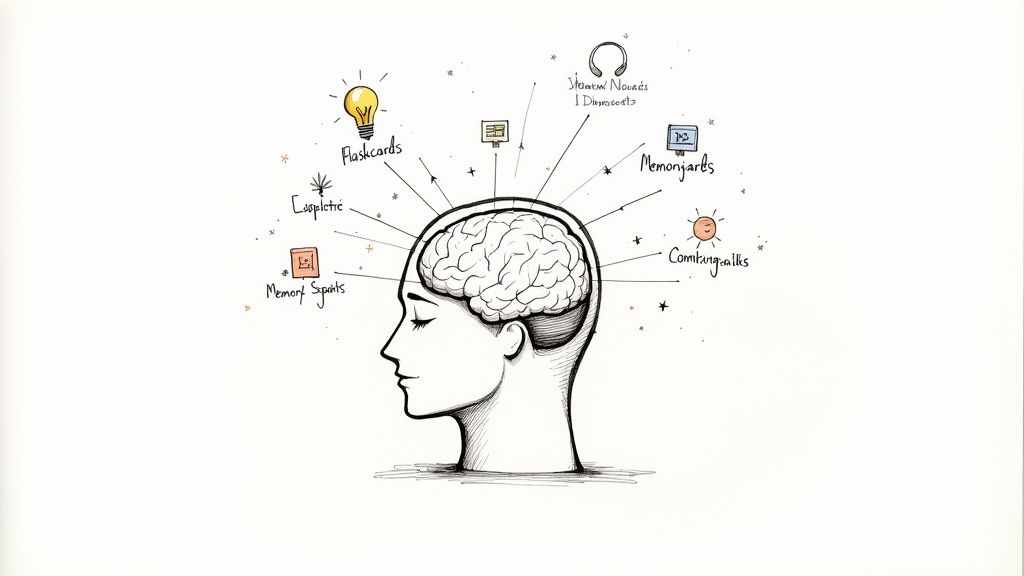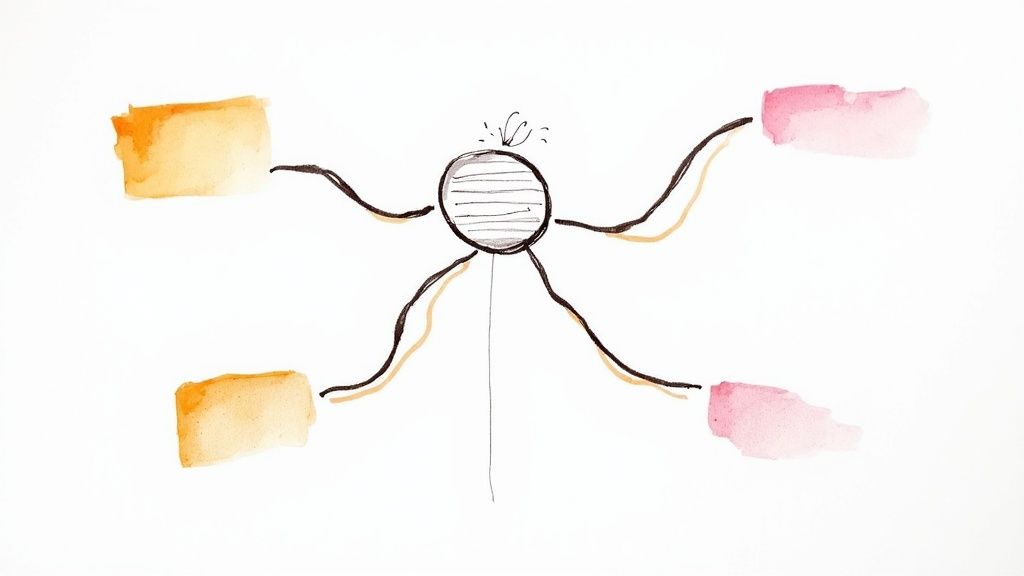
How to Retain Information Better with Science
To really make information stick, you have to move from just passively reviewing it to actively engaging with it. This isn't about willpower; it's about using proven, science-backed methods like spaced repetition and active recall to turn those fleeting facts into knowledge that actually lasts.
Why Your Brain Forgets and How to Fight It
Have you ever read an entire chapter, only to realize the next day that you barely remember a thing? It’s frustrating, but it’s not a personal failing. It’s actually a core feature of how our brains are wired. Your brain is a master of efficiency, and that means it's constantly working to discard information it thinks is non-essential. It has to, or it would be completely overwhelmed.
This natural process was famously mapped out by psychologist Hermann Ebbinghaus, who developed the "forgetting curve." His research uncovered a pretty startling truth about our memory.
Without any effort to reinforce what we learn, we lose about 70% of that new information within the first 24 hours. But by strategically revisiting that information over time, you can flip that number on its head.
This is exactly why cramming for a test feels so pointless in the long run. Sure, you might hold onto the facts long enough to pass, but the information vanishes almost immediately afterward. You never gave your brain the right signals to mark it as important for long-term storage. In fact, modern studies have shown that spacing out your learning can boost retention by up to 80% compared to cramming everything in at once.

From Passive Reading to Active Engagement
The secret to beating the forgetting curve is making the switch from passive consumption to active engagement. Passive activities, like just re-reading a textbook or watching a presentation without interacting, create incredibly weak memory traces. To your brain, it’s just background noise.
Active engagement, on the other hand, is like building a superhighway in your brain. It carves out strong, durable neural pathways and sends a clear message: "Hey, this is important! Keep this." If you truly want to learn how to retain information, you have to make this shift.
So, how do you do it? The rest of this guide is going to break down the most effective, science-backed strategies to help you do just that. We'll get into powerful methods that force your brain to work, turning the act of learning into something truly memorable.
Before we dive into the specific techniques, it's helpful to see the core ideas at a glance. These are the fundamental strategies we'll be building on to combat the natural process of forgetting.
Core Principles for Better Information Retention
By adopting these active strategies, you're not just fighting your brain's tendency to forget—you're working with it. You're giving it the exact signals it needs to encode, store, and reliably pull up information whenever you need it. This is your roadmap to turning fragile knowledge into permanent understanding, starting now.
Putting Spaced Repetition into Practice
Alright, so we've talked about the science behind spaced repetition. It all sounds great in theory, but how do you actually do it without it turning into a massive headache? The real magic happens when you move from concept to consistent, daily action.
The core idea is simple: you want to interrupt the brain's natural "forgetting curve" right before a memory is about to fade away. It’s all about timing.
A fantastic starting point that I often recommend is the 1-3-7-14 model. You review new information one day after you first learn it, then three days later, then seven, and finally fourteen days after that. Each time you recall it, you're signaling to your brain, "Hey, this is important! Don't throw it out." This process helps move knowledge from short-term recall into genuine, long-term memory.
If you really want to dive deep into the nuts and bolts, there are some excellent guides on how the spaced repetition study method boosts memory that break it down even further.
Choosing Your Tools
Now for the fun part. You don't need fancy, expensive software to get started. The best tool is simply the one you'll actually use.
- Low-Tech Flashcards: You can't go wrong with classic index cards. Seriously. Write a question on one side and the answer on the other. A simple box system, like the Leitner method, works wonders for manually tracking your review piles based on how well you know the material.
- Digital Apps: If you prefer something more automated, tools like Anki are a game-changer. They use smart algorithms to schedule reviews for you based on your performance, taking all the guesswork out of the process.
This visual gives you a simple workflow for creating memorable learning cues, which is the foundation for any good spaced repetition system.

As you can see, it all starts with boiling down the information to its core ideas before you even think about making flashcards or cues.
Making It a Sustainable Habit
Here’s where most people stumble. The key to making spaced repetition work for the long haul is to build it into a manageable daily habit, not a dreaded chore. Trust me, trying to cram hundreds of new flashcards on day one is a surefire way to burn out.
Start small. I mean really small. Aim to create just five to ten new "cards" each day, focusing on a single topic. Whether it's vocabulary for a new language or key stats for a work presentation, keeping it focused makes it stick.
A tiny, consistent effort every day will always beat sporadic, marathon study sessions. You're building a system that reinforces learning over weeks and months, not just for a test next week. This is what truly makes the difference.
Harnessing the Power of Active Recall
If you really want information to stick, you have to move beyond just passively consuming it. We need to become active participants in our own learning. So many common study habits—like re-reading your notes or highlighting half the page—only create a false sense of familiarity. Your brain recognizes the material, sure, but that’s a world away from being able to recall it when it counts.
This is where active recall, sometimes called retrieval practice, completely changes the game.
Active recall is the simple, powerful act of deliberately pulling information out of your brain. Instead of just looking at the answer, you force your mind to go find it. That mental effort is precisely what strengthens the neural pathways for that memory, making it tougher and much easier to access down the road.
Think of it like exercise. Passively re-reading is like watching someone else lift weights. Active recall is you actually doing the lifting. The struggle is what builds the muscle.

From Passive Watching to Active Retrieving
So, how do you actually do this? It's way simpler than it sounds. The main goal is just to create moments where you have to produce the information yourself, without any help. A classic and highly effective way to do this is by regularly testing yourself with things like quizzes, such as a Hanafi Fiqh Quiz.
But there are other great ways to work active recall into your routine:
- Try the "Brain Dump" Method: After you finish a chapter or watch a video, shut the book or pause the player. Get out a blank piece of paper and just write down everything you can remember. This forces you to retrieve the core concepts without any cues.
- Summarize It Aloud: Don't just copy down definitions. Try to explain a complex topic out loud as if you were teaching a friend who knows nothing about it. If you can't put it into simple terms, you probably don't understand it as well as you thought you did.
This is the mental workout that turns fleeting facts into knowledge that lasts.
Teach It to Solidify It
One of the most profound ways to put active recall into practice is the Feynman Technique, named after the Nobel Prize-winning physicist Richard Feynman. It's a straightforward process, but it's incredibly powerful.
First, pick a concept you're trying to learn. Then, try to teach it to someone else (or even just an imaginary student). Explain the topic from start to finish using simple language and analogies. The moment you get stuck or can't explain a part clearly, you've pinpointed a gap in your understanding. Go back to your source material, fill in that gap, and then try teaching it again.
This method transforms learning from a one-way street of information intake into a dynamic, two-way process.
Even something as simple as watching a video can be supercharged with this approach. Instead of just letting it play, you can draw inspiration from various active learning strategies to turn a passive viewing into an interactive session. By pausing to ask yourself questions or trying to predict what comes next, you’re practicing a form of active recall that cements the information in your memory.
Building Connections with Elaboration and Association
Information just floating around in your head doesn't tend to stick. If you really want to learn how to retain information better, you have to do more than just cram isolated facts into your brain. The real goal is to build a rich, interconnected web of knowledge, a process known as elaboration. It's all about actively tying new ideas to what you already understand.
For example, instead of just trying to memorize a dry historical date, think about how it connects to a story you already know from that time, or a historical figure you've already studied. This doesn't just add one more fact to your mental library; it weaves that new fact into the existing tapestry, giving you multiple ways to pull it up later.
The core idea is simple but incredibly powerful: the more connections a piece of information has, the more likely you are to remember it. Standalone facts are fragile. Connected ideas are resilient.
This is exactly why analogies work so well for learning. When someone explains that an atom is structured like a solar system, you're not just memorizing a new definition. You're anchoring a complex, abstract concept to a familiar one. That creates a mental shortcut that makes the new idea feel instantly more intuitive and memorable.
Create Mental Models and Visual Maps
One of the best hands-on ways to build these connections is by creating mental models or visual maps. And no, you don't need to be an artist. A simple diagram scribbled on a napkin can be surprisingly effective at showing how different pieces of a puzzle fit together.
If you’re trying to get your head around a new business process, don't just read the steps—draw a flowchart. If you're studying an ecosystem, sketch out the food web. The physical act of organizing the information forces your brain to think about the relationships between the parts. You're shifting from just memorizing to actually understanding.
Here are a few practical ways to get started:
- Lean on Analogies: Link a new, complicated topic to a simple concept you already get. For example, think of your working memory as a small workbench—it can only hold a few tools at once.
- Tell a Story: Weave those dry facts into a narrative. Remembering a list of historical events is a slog, but remembering a story about how one event caused the next? Much, much easier.
- Picture It: Create a vivid mental image. There's a classic memory trick called the "Baker/baker paradox" that proves you're more likely to remember someone's name is Baker if you picture them wearing a baker's hat and covered in flour. That visual hook is strong.
Make Learning an Active Assessment
When you actively try to build these associations, you're also doing a form of self-testing on the fly. You quickly find out what you really get and where the gaps are.
This constant, low-stakes checking is a critical part of pushing information into your long-term memory. By continuously assessing learning as it happens, you turn a passive activity into a dynamic process of building, testing, and strengthening your knowledge. That’s how you make sure what you learn today is still there when you need it tomorrow.
Taming Information with Effective Chunking
Ever feel like you’re trying to drink from a firehose? When you're faced with a mountain of new information, it’s easy to feel completely swamped. That feeling of being overloaded isn't just in your head—it’s a real cognitive state where your brain basically says, "I'm done," and stops retaining anything new.
This is where a brilliant little mental trick called chunking saves the day.
At its core, chunking is just the simple act of breaking down a big, intimidating topic into smaller, bite-sized pieces. It's a strategy that works with the natural limits of our working memory—the mental space where we actively process information. Your brain already does this instinctively. Think about a phone number. You don't see it as 5558675309; you see it as 555-867-5309. Those little groups are chunks.
By grouping related items together, you’re not asking your brain to juggle a dozen different facts at once. Instead, you're giving it a few neat packages, which frees up a ton of mental bandwidth to actually understand what you're learning.

How to Find the Chunks
So, how does this work in practice when you're tackling something complex? The secret is to actively hunt for the natural breaks and logical connections within the material. Your mission is to turn a chaotic mess of facts into a structured framework that actually makes sense.
Let's say you're learning about the history of World War II. A straight timeline can be dense and forgettable. Instead, try chunking it thematically:
- The Run-Up to War: Group everything related to the Treaty of Versailles, the rise of fascism, and the policy of appeasement.
- Major Theaters of Conflict: Create separate mental buckets for the European Front, the Pacific Front, and the battles in North Africa.
- Key Turning Points: Zero in on major events like the Battle of Stalingrad or D-Day as their own distinct, mini-lessons.
When you organize information this way, you stop trying to just memorize isolated dates. You start building a mental map where every piece connects to another, forming a cohesive story.
Chunking isn't about memorizing less; it's about organizing more. You’re giving your brain a logical filing system, making both storage and retrieval significantly easier and more efficient.
Chunking in the Real World
This isn't just some academic theory—it's how experts in every field learn and master their craft, often without even thinking about it. A musician doesn't learn a new song one note at a time. They learn it measure by measure, or even phrase by phrase. Each musical phrase is a "chunk."
It's the same for a developer learning a new programming language. They don't try to swallow the entire library of commands at once. They master concepts in logical blocks:
- First, they tackle variables and data types—the absolute fundamentals.
- Next, they move on to conditional logic, learning how
if-elsestatements create decisions. - Then, they master loops to understand how to repeat actions.
Each of these is a conceptual chunk that builds on the last. By mastering one before moving on, they can eventually tackle incredibly complex programs without getting overwhelmed. You can use this exact same approach for anything, whether you're learning a new recipe by grouping ingredients and steps, or mastering a new business strategy by breaking it down into actionable phases.
Integrating These Techniques into Your Daily Routine
Knowing about powerful learning techniques is one thing, but actually weaving them into the fabric of your daily life is where the magic happens. It's the difference between theory and results. This is where we move past the what and into the how, creating a sustainable system that sticks, whether you're a professional getting up to speed on new industry tech or a student trying to ace exams without the last-minute cram session.
The real goal is to build habits, not just check off tasks. You want these methods to feel as natural as checking your email in the morning. A great way to start is by simply looking at your week and finding those little pockets of time where you can slide in a quick review or recall session.
For example, a sales pro learning a new product line could spend 15 minutes each morning flipping through flashcards of key features (hello, spaced repetition). Then, maybe another 10 minutes after lunch trying to explain one of those features to an imaginary client (that’s active recall in action). This approach is far more effective than trying to brute-force an hour of studying on a Sunday night.
Creating a Sustainable Learning Schedule
A bit of structure is your best friend here. It prevents these powerful methods from getting lost in the shuffle of a busy week. The key is to mix and match different techniques to keep your brain on its toes and reinforce what you've learned from multiple angles.
Here’s a sample weekly flow you can tweak to fit your own needs:
- Monday & Tuesday (Learn & Elaborate): This is when you tackle new material. As you go, actively use elaboration. Hit pause and ask yourself, "How does this connect to something I already know?" or "What's a simple analogy for this concept?"
- Wednesday (Active Recall): Time to put your notes away. Take 20 minutes for a "brain dump." On a blank page, just write down everything you can remember from what you learned on Monday and Tuesday. This will immediately show you where the gaps are.
- Thursday & Friday (Spaced Repetition): Use these days for scheduled reviews of older stuff. Revisit concepts from last week or even last month. This is where a simple flashcard app or a physical card system really proves its worth.
Staying Motivated and Adjusting Your Strategy
Consistency is king, but you also need to be flexible. Some topics are just dense and might require more chunking upfront. Others are perfect for those quick, on-the-go recall sessions. The most important thing is to pay attention to what's working for you and be willing to adjust your approach.
I’ve found that a simple journal or a spreadsheet where you jot down what you reviewed and how well you recalled it can be a huge motivator. Seeing your progress in black and white is tangible proof that your effort is paying off, which makes it so much easier to stick with the routine.
This whole process turns learning from a passive chore into an active, engaging pursuit. For more ideas on making your learning even more interactive and memorable, check out these 5 reasons to use interactive video for training or educational content. By building a system that combines these proven methods, you’re creating a powerful engine for knowledge retention that becomes a natural part of how you learn and grow.
Got Questions About Retaining Information? We’ve Got Answers.
Even after you've got a handle on powerful methods like spaced repetition and active recall, some questions always pop up. It's only natural to wonder how these techniques actually play out in the real world and what you can realistically expect.
Let's dig into some of the most common things people ask when they start getting serious about making information stick.
How Quickly Will I See Results?
This is probably the biggest question on everyone's mind. You're excited to try these new strategies, but when does the magic happen? The honest answer is: it depends on the method.
With a technique like active recall, you can feel a benefit almost instantly. The very first time you close the book and force your brain to summarize a concept without looking, you're forging a stronger neural connection. You feel the difference in real-time.
But for true, lasting retention, something like spaced repetition is a long game. Its real power shines through after a few weeks of consistent practice. It's not about an overnight fix, but about building a sustainable, long-term learning habit.
Can I Combine These Methods?
Absolutely—in fact, you should. These techniques aren't designed to be used in silos. They're most powerful when they work together as part of a complete learning system.
There's no single "best" combination that works for everyone, but a workflow I’ve seen be incredibly effective looks something like this:
- First, Chunk It Down: Before you do anything else, break that overwhelming topic into smaller, logical pieces.
- Then, Elaborate: As you tackle each chunk, connect it to things you already understand. Use analogies, create stories, or explain it to a friend.
- Finally, Recall and Repeat: Use active recall for your daily practice sessions and bring in spaced repetition to schedule your reviews for long-term mastery.
Experiment with that flow. See how it feels for the subject you're tackling and tweak it to fit your own style.
The key takeaway here is that these methods are synergistic. Chunking makes information manageable, elaboration makes it meaningful, and recall paired with repetition makes it permanent. Think of them as different tools in the same toolbox, each with a specific job.
Are Digital Tools a Must-Have?
Nope, you don't strictly need digital tools. But they can make implementing these strategies—especially spaced repetition—a whole lot easier and more efficient.
Apps like Anki or RemNote use sophisticated algorithms to automatically schedule when you should review information. They take all the manual planning and guesswork out of the equation, which is a massive help when you're busy.
That said, a simple pen-and-paper approach can be just as effective if you stick with it. The classic Leitner system, which uses a few boxes to sort physical flashcards based on how well you know them, is a time-tested analog method that works beautifully.
Ultimately, the best tool is the one you’ll actually use consistently, whether it’s a smart app or a humble stack of index cards.
Ready to make your educational or training content unforgettable? Mindstamp transforms passive videos into interactive experiences with embedded questions, quizzes, and personalized paths that boost engagement and retention. Discover how Mindstamp can elevate your content today.
Get Started Now
Mindstamp is easy to use, incredibly capable, and supported by an amazing team. Join us!



Try Mindstamp Free










